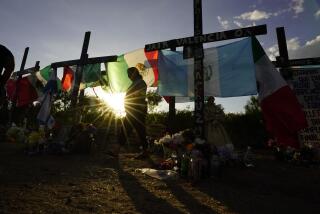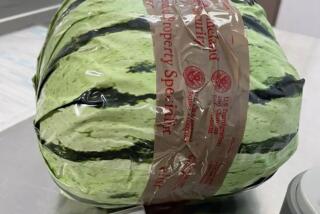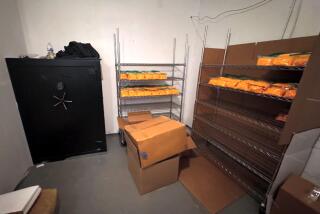âA Straight Shot Into ... Mexicoâ
SAN DIEGO â Fifty feet underneath the warehouse, groundwater drips from the jagged sandstone walls of the longest illegal tunnel ever found under a U.S. border.
The tunnel makes a sharp turn south and, lit by a string of 60-watt bulbs, extends a third of a mile farther, all the way to the U.S.-Mexico border.
âYouâre looking at a ... straight shot into the Republic of Mexico,â said Frank Marwood, acting deputy special agent in charge for Immigration and Customs Enforcement.
Federal officials gave U.S. and Mexican media a rare look at a smuggling tunnel Monday as they announced the arrest of a man with alleged ties to a Mexican drug cartel that authorities suspect built the 2,400-foot-long passage.
Carlos Eugenio Cardenas-Calvillo, who allegedly works for the warehouse operators in Otay Mesa, Calif., V & F Distributors LLC, was arraigned Monday on drug conspiracy charges.
V & F rented the 50,000-square-foot building as a produce-processing facility but used it as a front for narcotics trafficking, according to the criminal complaint. Authorities who raided the tunnel Wednesday found 2 tons of marijuana.
The arrest, which occurred Saturday, was considered a major breakthrough, but authorities fear that additional witnesses and suspects may be killed by the cartel. The tunnel took about 18 months to build, and was operational only since November, according to the court documents.
âWeâre afraid that the two people we want to talk to are going to be dead pretty soon,â said one source close to the investigation. The source, who spoke on condition of anonymity, said cartel members are probably angry that the tunnel was discovered so quickly after its completion.
The passage starts in a small warehouse near a runway at the Tijuana Airport and follows a northeasterly line -- eight football fields long -- to the warehouse on Siempre Viva Road in Otay Mesa.
Inside the warehouse, the tunnelâs exit was concealed inside a small office. The traffickers, from inside the tunnel, had to push up a 150-pound tile slab cutout -- affixed with wheels so it could be easily rolled aside -- to enter the building.
Such clever engineering is apparent throughout the tunnel, said Marwood.
âThe amount of time, money and technology it would take to make a tunnel like this is overwhelming. Itâs a complete engineering feat,â he said.
Even so, Marwood before the tour warned reporters and photographers who might have âconfined-space issuesâ that conditions inside could induce claustrophobia.
But fainters had nothing to fear. âIf you spontaneously hit the dirt, we can take care of that,â he said.
âIâm not going to go all the way in,â said Phil Blauer, a television news reporter with Channel 8 News in San Diego, who turned back 50 yards into the tunnel.
âIt gets a little creepy.... Itâs intimidating,â said Blauer.
On the Mexican side, one must descend a 50-foot shaft by ladder to reach the tunnel floor. A pulley system allowed the smugglers to lower their shipments.
But in Otay Mesa, the entry shaft is about 8 feet deep, leading to a passage that begins a steep descent. The floor is concrete and cross-hatched so people can keep their footing.
Still, a slip could lead to a tumble. There are no rails, and the clay and sandstone walls provide no place to grip.
Strung along the right wall is plastic piping used for ventilation. Cords and cables line the other wall, and outlets provided electricity for power tools authorities believe were used to carve out the tunnel.
The tunnel here most resembles a mine shaft. A 6-footer could walk through without having to duck very often. Itâs wide enough -- about 4 feet -- for people to pass each other with ease.
But at the bottom of the initial descent -- about 50 feet down -- the tunnel height drops about a foot and narrows. Marwood compared it to a roller coaster. âItâs like when you go into the dark tunnel in any amusement park,â he said.
At this point, cameramen complained that their lenses were fogging up in the damp air. Voices sounded like dull echoes.
At the tunnelâs turn south, reporters were allowed a look at its main corridor -- the nearly half-mile long passage into Mexico. Several planks floated in dark water. The tunnel also has a pumping system to remove groundwater, but the water here was about a foot deep. The tunnel, at its deepest, is about 80 feet underground, and the water pools in greater concentrations farther down.
Last week, Mexican and U.S. agents walked the entire length of the tunnel in their attempt to find the U.S. opening. On Monday, an armed Immigration and Customs agent prevented anyone from going farther.
The half-hour tour covered an estimated 250 feet, about one-tenth of the tunnelâs length. Still, it was too much for Tatiana Martinez, a reporter for El Mexicano, a Tijuana-based newspaper.
âI tried but I couldnât,â said Martinez, who complained of shortness of breath. âNot knowing where I was going was too much for me.â
More to Read
Sign up for Essential California
The most important California stories and recommendations in your inbox every morning.
You may occasionally receive promotional content from the Los Angeles Times.











